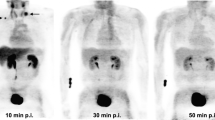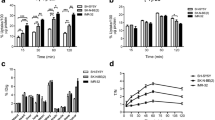Abstract
Introduction
Glioblastoma (GBM) is the most frequent and aggressive primary tumor of the central nervous system, accounting for over 50% of all primary malignant gliomas arising in the adult brain. Even after surgical resection, adjuvant radiotherapy (RT) and temozolomide (TMZ) chemotherapy, as well as tumor-treating fields, the median survival is only 15–20 months. We have identified a pathogenic mechanism that contributes to the tumor-induced immunosuppression in the form of increased indoleamine 2,3 dioxygenase 1 (IDO1) expression; an enzyme that metabolizes the essential amino acid, tryptophan (Trp), into kynurenine (Kyn). However, real-time measurements of IDO1 activity has yet to become mainstream in clinical protocols for assessing IDO1 activity in GBM patients.
Methods
Pre-treatment and on-treatment α-[11C]-methyl-l-Trp (AMT) positron emission tomography (PET) with co-registered MRI was performed on patients with recurrent GBM treated with the IDO1 pathway inhibitor indoximod (D1-MT) and TMZ.
Results
Regional intratumoral variability of AMT within enhancing and non-enhancing tumor was noted at baseline. On treatment imaging revealed decreased regional uptake suggesting IDO1 pathway modulation with treatment.
Conclusions
Here, we have validated the ability to use PET of the Trp probe, AMT, for use in visualizing and quantifying intratumoral Trp uptake in GBM patients treated with an IDO1 pathway inhibitor. These data serve as rationale to utilize AMT-PET imaging in the future evaluation of GBM patients treated with IDO1 enzyme inhibitors.



Similar content being viewed by others
References
Ostrum QT, Gittleman H, Xu J et al (2016) The CBTRUS statistical report: primary brain and central nervous system tumors diagnosed in the United States in 2009–2013. Neuro Oncol 18(suppl 5):v1–v75
Stupp R, Mason WP, van den Bent MJ et al (2005) Radiotherapy plus concomitant and adjuvant temozolomide for glioblastoma. N Engl J Med 352:987–996
Stupp R, Taillibert S, Kanner A et al (2017) Effect of tumor-treating fields plus maintenance temozolomide vs maintenance temozolomide alone on survival in patients with glioblastoma: a randomized clinical trial. JAMA 318:2306–2316
Lukas RV, Mrugala MM (2017) Pivotal trials for infiltrating gliomas and how they affect clinical practice. Neuro Oncol Pract 4:209–219
Sampson JH, Maus MV, June CH (2017) Immunotherapy for brain tumors. J Clin Oncol 35:2450–2456
Binder DC, Davis AA, Wainwright DA (2015) Immunotherapy for cancer in the central nervous system: current and future directions. Oncoimmunology 5:e1082027
Huang RY, Neagu MR, Reardon DA, Wen PY (2015) Pitfalls in the neuroimaging of glioblastoma in the era of antiangiogenic and immuno/targeted therapy-detecting elusive disease, defining response. Front Neurol 6:33
Okada H, Weller M, Huang R et al (2015) Immunotherapy response assessment in neuro-oncology: a report of the RANO working group. Neuro Oncol 16:e534–e542
Zhai L, Ladomersky E, Lauing KL et al (2017) Infiltrating T cells increase IDO1 expression in glioblastoma and contribute to decreased patient survival. Clin Cancer Res 23:6650–6660
Wainwright DA, Balyasnikova IV, Chang AL et al (2012) IDO expression in brain tumors increases the recruitment of regulatory T cellsand negatively impacts survival. Clin Cancer Res 18:6110–6121
Munn DH, Shafizadeh E, Attwood JT, Bondarev I, Pashine A, Mellor AL (1999) Inhibition of T cell proliferation by macrophage tryptophan catabolism. J Exp Med 189:1363–1372
Mezrich JD, Fechner JH, Zhang X, Johnson BP, Burlingham WJ, Bradfield CA (2010) An interaction between kynurenine and aryl hydrocarbon receptor can generate regulatory T cells. J Immunol 185:3190–3198
Wainwright DA, Chang AL, Dey M et al (2014) Durable therapeutic efficacy utilizing combinatorial blockade against IDO, CTLA-4, and PD-L1 in mice with brain tumors. Clin Cancer Res 20:5290–5301
Soliman HH, Jackson E, Neuger T et al (2014) A first in man phase I trial of the oral immunomodulator, indoximod, combined with docetaxel in patients with metastatic solid tumors. Oncotarget 5:8136–8146
Hanihara M, Kawataki T, Oh-Oka K, Mitsuka K, Nakao A, Kinouchi H (2016) Synergistic anti-tumor effect with indoelamine 2,3-dioxygenase inhibition and temozolomide in a murine glioma model. J Neurosurg 124:1594–1601
Colman H et al (2015) A phase 1b/2 study of the combination of the IDO pathway inhibitor indoximod and temozolomide for adult patients with temozolomide-refractory primary malignant brain tumors: safety analysis and preliminary efficacy of the phase 1b component. J Clin Oncol 33(15_suppl):2070
Zakharia Y, Colman H, Mott F et al (2015) Updates on phase 1B/2 combination study of the IDO pathway ihibitor indoximod with temozolomide for adult patients with temozolomide-refractory primary malignant brain tumors. Neuro Oncol 17:v112
Zakharia Y, Munn D, Link C, Vahanian N, Kennedy E (2016) Interim analysis of phase 1B/2 combination study of the IDO pathway inhibitor indoximod with temozolomide for adult patients with temozolomide-refractory primary malignant brain tumors. ACTR-53 Neuro Oncol 18(Suppl_6):vi13–vi14
Zhai L, Spranger S, Binder DC et al (2015) Molecular pathways: targeting IDO and other tryptophan dioxygenases for cancer immunotherapy. Clin Cancer Res 21:5427–5433
Zhai L, Ladomersky E, Lenzen A et al (2018) IDO1 in cancer: a gemini of immune checkpoints. Cell Mol Immunol 15:447–457
Ladomersky E, Zhai L, Lenzen A et al (2018) IDO1 inhibition synergizes with radiation and PD1 blockade to durably increase survival against advanced glioblastoma. Clin Cancer Res. https://doi.org/10.1158/1078-0432.CCR-17-3573
Beatty GL et al (2017) First-in-human phase I study of the oral inhibitor of indoleamine 2,3-dioxygenase-1 epacadostat (INCB024360) in patients with advanced solid malignancies. Clin Cancer Res 23:3269–3276
Siu LL, Gelmon K, Chu Q et al (2017) BMS-986205 an optimized indoelamine 2,3-dioxygenase 1 (IDO1) inhibitor, is well tolerated with potent pharmacodynamics activity, alone and in combination with nivolumab in advanced cancers in a phase 1/2a trial. Abstract CT116. Cancer Res 77(13 Suppl):CT116
Chugani DC, Muzik O (2000) Alpha[C-11]methyl-L-tryptophan PET maps brain serotonin synthesis and kynurenine pathway metabolism. J Cereb Blood Flow Metab 20(1):2–9
Madras BK, Sourkes TL (1965) Metabolism of alpha-methyltryptophan. Biochem Pharmacol 14:1499–1506
Diksic M, Nagahiro S, Sourkes TL (1990) Biological model for the in vivo measurement of rate of serotonin synthesis in the brain. J Neural Transm 29:131–140
Guastella AR, Michelhaugh SK, Klinger NV et al (2016) Tryptophan PET imaging of the kynurenine pathway in patient-derived xenograft models of glioblastoma. Mol Imaging. 15:1536012116644881
Bosnyak E, Kamson DO, Robinette NL et al (2016) Tryptophan PET predicts spatial and temporal patterns of post-treatment glioblastoma progression detected by contrast-enhanced MRI. J Neurooncol 126:317–325
Jeong JW, Juhasz C, Mittal S et al (2015) Multi-modal imaging of tumor cellularity and tryptophan metabolism in human gliomas. Cancer Imaging 15:10
Bosnyak E, Michelhaugh SK, Klinger NV et al (2017) Prognostic and molecular imaging biomarkers in primary glioblastoma. Clin Nucl Med 42:341–347
Juhasz C et al (2006) In vivo uptake and metabolism of alpha-[11C]methyl-L-tryptophan in human brain tumors. J Cereb Blood Flow Metab 26:345–357
Kamson DO et al (2013) Differentiation of glioblastomas from metastatic brain tumors by tryptophan uptake and kinetic analysis: a positron emission tomographic study with magnetic resonance imaging comparison. Mol Imaging 12:327–337
Batista CE et al (2009) Imaging correlates of differential expression of indoleamine 2,3-dioxygenase in human brain tumors. Mol Imaging Biol 11:460–466
Kamson DO et al (2014) Increased tryptophan uptake on PET has strong independent prognostic value in patients with a previously treated high-grade glioma. Neuro Oncol 16:1373–1383
Bosnyak E, Barger GR, Michelhaugh SK et al (2018) Amino acid PET imaging of the early metabolic response during tumor-treating fields (TTFields) therapy in recurrent glioblastoma. Clin Nucl Med 43:176–179
Chakraborty PK et al (1996) A high-yield and simplified procedure for the synthesis of alpha-[11C]methyl-L-tryptophan. Nucl Med Biol 23:1005–1008
Kikinis R, Pieper S (2011) 3D Slicer as a tool for interactive brain tumor segmentation. Conference proceedings: Annual International Conference of the IEEE Engineering in Medicine and Biology Society IEEE. Eng Med Biol Soc Conf 2011:6982–6984. https://doi.org/10.1109/IEMBS.2011.6091765
Fedorov A et al (2012) 3D Slicer as an image computing platform for the Quantitative Imaging Network. Magn Reson Imaging 30:1323–1341
Mattes D, Haynor DR, Vesselle H, Lewellen TK, Eubank W (2003) PET-CT image registration in the chest using free form deformations. IEEE Trans Med Imaging 22:120–128
Woodard HQ, Bigler RE, Freed B (1975) Letter: expression of tissue isotope distribution. J Nucl Med 16:958–959
Patlak CS, Blasberg RG, Fenstermacher JD (1983) Graphical evaluation of blood-to-brain transfer constants from multiple-time uptake data. J Cereb Blood Flow Metab 3:1–7
Bosnyak E, Kamson DO, Guastella AR, et al (2015) Molecular imaging correlates of tryptophan metabolism via the kynurenine pathway in human meningiomas. Neuro-Oncology 17:1284–1292
Wen PY, Macdonald DR, Reardon DA et al (2010) Updated response assessment criteria for high-grade gliomas: response assessment in neuro-oncology working group. J Clin Oncol 28:1963–1972
Brandes AA, Franceschi E, Tosoni A et al (2008) MGMT promoter methylation status can predict the incidence and outcome of pseudoprogression after concomitant chemoradiotherapy in newly diagnosed glioblastoma patients. J Clin Oncol 26:2192–2197
Zhu X, McDowell MM, Newman WC et al (2017) Severe cerebral edema following nivolumab treatment for pediatric glioblastoma: case report. J Neurosurg Pediatr 19:249–253
Ranjan S, Quezado M, Garren N et al (2018) Clinical decision making in the era of immunotherapy for high grade-glioma: report of four cases. BMC Cancer 18:239
Hassanzadeh C, Rao YJ, Chundury A et al (2017) Multiparametric MRI and [18F]fluorodeoxyglucose positron emission tomography imaging is a potential prognostic imaging biomarker in recurrent glioblastoma. Front Oncol 7:178
Antonios JP, Soto H, Everson RG et al (2017) Detection of immune responses after immunotherapy in glioblastoma using PET and MRI. Proc Natl Acad Sci USA 114:10220–10225
Nandu H, Wen PY, Huang RY (2018) Imaging in neuro-oncology. Ther Adv Neurol Disord 11:1756286418759865
Opitz CA, Litzenburger UM, Sahm F et al (2011) An endogenous tumor-promoting ligand of the human aryl hydrocarbon receptor. Nature 478:197–203
Forouhar F, Anderson JL, Mowat CG et al (2007) Molecular insights into substrate recognition and catalysis by tryptophan 2,3-dioxygenase. Proc Natl Acad Sci USA 104:473–478
Basran J, Rafice SA, Chauhan N et al (2008) A kinetic, spectroscopic, and redox study of human tryptophan 2,3-dioxygenase. Biochemistry 47:4752–4760
Giglio BC, Fei H, Wang M et al (2017) Synthesis of 5-[(18)F]fluoro-alpha-methyl tryptophan: new Trp based PET agents. Theranostics 7:1524–1530
Funding
M.S. Lesniak is supported by PHS Grant Numbers R01NS093903 awarded by the NIH/NINDS, and P50CA221747 awarded by the NIH/NCI, U.S. Department of Health and Human Services. R.V. Lukas is supported by PHS Grant Number R01NS093903 awarded by the NIH/NINDS and P50CA221747 awarded by the NIH/NCI, U.S. Department of Health and Human Services. D.A. Wainwright is supported by PHS Grant Number R01NS097851 awarded by the NIH/NINDS and P50CA221747 awarded by the NIH/NCI, U.S. Department of Health and Human Services. C. Juhasz is supported by PHS Grant Number R01NS093903 awarded by the NIH/NINDS, and R01CA123451 and P50CA221747 awarded by the NCI/NIH, U.S. Department of Health and Human Services. C.D. James is supported by PHS Grant Number P50CA221747 awarded by the NCI/NIH, U.S. Department of Health and Human Services. R. Stupp is supported by PHS Grant Number P50CA221747 awarded by the NIH/NCI, U.S. Department of Health and Human Services.
Author information
Authors and Affiliations
Corresponding author
Ethics declarations
Conflict of interest
E. Kennedy is an employee of New Link Genetics. All other authors report no conflicts of interest.
Ethical approval
This research was conducted in compliance with the ethical standards of the institutional research committees and with the 1964 Helsinki declaration and its later amendments or comparable ethical standards.
Informed consent
All patients provided signed informed consent for participation in this research.
Rights and permissions
About this article
Cite this article
Lukas, R.V., Juhász, C., Wainwright, D.A. et al. Imaging tryptophan uptake with positron emission tomography in glioblastoma patients treated with indoximod. J Neurooncol 141, 111–120 (2019). https://doi.org/10.1007/s11060-018-03013-x
Received:
Accepted:
Published:
Issue Date:
DOI: https://doi.org/10.1007/s11060-018-03013-x




